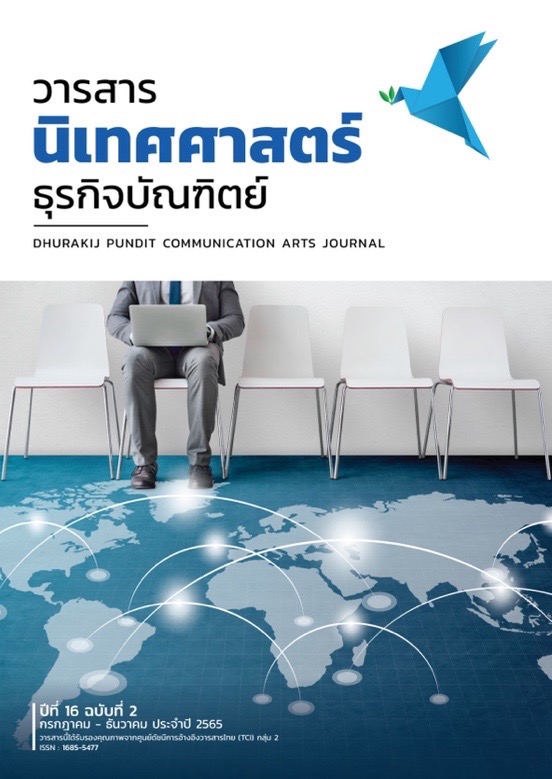ความแตกต่างของเพศ และกลุ่มการเรียน ที่มีผลต่อการเปิดรับข่าวสารด้านการเมืองของนักศึกษาในภาคตะวันออกเฉียงเหนือ
คำสำคัญ:
การเปิดรับข่าวสาร, การเมือง, เพศ, กลุ่มการเรียน, นักศึกษาบทคัดย่อ
การเปิดรับข่าวสารด้านการเมืองผ่านสื่อใหม่มีอิทธิพลต่อการหล่อหลอมความคิด ทัศนคติ และพฤติกรรมของบุคคล ภาคตะวันออกเฉียงเหนือนับเป็นหัวใจสำคัญในการเลือกตั้งของประเทศ เพราะมีจำนวนผู้มีสิทธิ์เลือกตั้งมากที่สุด โดยเฉพาะกลุ่มเยาวชน ซึ่งมีบทบาททางการเมืองเพิ่มสูงขึ้น คุณลักษณะส่วนบุคคลด้านเพศ และกลุ่มการเรียนจึงอาจส่งผลต่อการเลือกเปิดรับข่าวสารที่แตกต่างกัน การวิจัยนี้มีวัตถุประสงค์เพื่อศึกษาความแตกต่างของเพศ และกลุ่มการเรียน ที่มีผลต่อการเปิดรับข่าวสารด้านการเมืองของนักศึกษา กลุ่มตัวอย่างในการศึกษามีจำนวน 1,200 ราย ซึ่งใช้การสุ่มตัวอย่างแบบหลายขั้นตอน (multi-stage sampling) จากนักศึกษาระดับปริญญาตรีในภาคตะวันออกเฉียงเหนือ สังกัดมหาวิทยาลัยในกำกับของรัฐ มหาวิทยาลัยรัฐ และมหาวิทยาลัยเอกชน ประเภทละ 400 ราย โดยลำดับแรกเป็นการสุ่มตัวอย่างอย่างง่ายตามประเภทมหาวิทยาลัยและกลุ่มการเรียน ได้แก่ วิทยาศาสตร์และเทคโนโลยี วิทยาศาสตร์สุขภาพ และมนุษยศาสตร์และสังคมศาสตร์ ลำดับต่อมาเป็นการสุ่มตัวอย่างอย่างมีระบบ โดยกำหนดลำดับที่ตามบัญชีรายชื่อนักศึกษาจากงานทะเบียนวิทยาลัย/สำนักทะเบียนและประมวลผลมหาวิทยาลัย เครื่องมือที่ใช้ในการเก็บรวบรวมข้อมูล คือ แบบสอบถาม ซึ่งได้ตรวจสอบความเที่ยงตรงเชิงเนื้อหา โดยผู้เชี่ยวชาญ จำนวน 5 ท่าน และทดสอบความเชื่อมั่นของเครื่องมือโดยใช้สูตรการหาค่าสัมประสิทธิ์แอลฟาของครอนบาค ได้ค่าความเชื่อมั่น 0.97 ผลการวิจัยพบว่า นักศึกษาที่มีเพศแตกต่างกันมีช่องทางการเปิดรับข่าวสารด้านการเมืองในภาพรวมแตกต่างกัน ที่ระดับนัยสำคัญทางสถิติที่ 0.05 นักศึกษาในกลุ่มการเรียนที่แตกต่างกันเปิดรับข่าวสารด้านการเมืองและมีช่องทางการเปิดรับข่าวสารด้านการเมืองในภาพรวมแตกต่างกัน ที่ระดับนัยสำคัญทางสถิติที่ 0.05 ผลการวิจัยนี้จะเป็นสารสนเทศและพื้นฐานสำคัญที่ช่วยผลักดันและพัฒนานักศึกษาให้เท่าทันข่าวสารด้านการเมือง และมีความพร้อมที่จะทำหน้าที่พลเมืองในสังคมประชาธิปไตยต่อไป
เอกสารอ้างอิง
กระทรวงการอุดมศึกษา วิทยาศาสตร์ วิจัย และนวัตกรรม. (2561). รายงานการอุดมศึกษา วิทยาศาสตร์ วิจัย และนวัตกรรม. สืบค้น 26 มีนาคม 2565, จาก http://info.mhesi.go.th/info/download.php?file_id=200910091749.xlsx&stat_id=109&id_member=
จรรยามาศ ปลอดแก้ว และจักรี ไชยพินิจ. (2562). พฤติกรรมการเปิดรับข่าวสารทางการเมืองของประชาชนในจังหวัดสมุทรปราการ. สืบค้น 5 พฤศจิกายน 2563, จาก http://www.mpm.ru.ac.th/Documents/Article_MPM18/35.pdf
จิราพร รุจิวัฒนากร. (2562). พฤติกรรมการใช้เครือข่ายสังคมออนไลน์เพื่อการศึกษา ของนักศึกษาปริญญาตรี มหาวิทยาลัยการกีฬาแห่งชาติ วิทยาเขตชัยภูมิ. วารสารสาระคาม. 12(1), 64-81
จุฑารัตน์ ศราวณวงศ์, ขจร ฝ้ายเทศ, ดวงแก้ว เงินพูนทรัพย์ และวัลลภา จันทรดี. (2560). พฤติกรรมการใช้สื่อสังคมออนไลน์ของนิสิตระดับปริญญาตรีมหาวิทยาลัยเกษตรศาสตร์. วารสารบรรณารักษศาสตร์ มศว. 10(2), 16-31.
ณฐมน หมวกฉิม. (2564). ปัจจัยที่ส่งผลต่อการตื่นตัวทางการเมืองของนักศึกษาชาวไทย. วารสารรัชต์ภาคย์. 15(38), 253-265.
นันทวิช เหล่าวิชยา. (2556). ความสัมพันธ์ระหว่างพฤติกรรมการเปิดรับสื่อออนไลน์ทางการเมืองทัศนคติทางการเมืองและพฤติกรรมการมีส่วนร่วมทางการเมืองของประชาชนในเขตกรุงเทพฯ. กรุงเทพฯ : มหาวิทยาลัยกรุงเทพ.
พรพรรณ จันทร์แดง. (2559). พฤติกรรมการใช้สื่อสังคมออนไลน์ของนักศึกษาระดับปริญญาตรีมหาวิทยาลัยพะเยา. วารสารมนุษยศาสตร์และสังคมศาสตร์ มหาวิทยาลัยพะเยา. 4(2), 44-54.
เยี่ยมยุทธ สุทธิฉายา. (2562). อ่านปัจจัยเลือกตั้งอีสาน เพื่อไทยยังมา แต่รอบหน้าอาจไม่แน่. สืบค้น 25 มกราคม 2565, จาก https://prachatai.com/journal/2019/03/81761
สำนักงานปลัดกระทรวงการอุดมศึกษา วิทยาศาสตร์ วิจัย และนวัตกรรม. (2563). สถาบันอุดมศึกษา. ค้นข้อมูล 25 พฤศจิกายน 2564, จาก http://www.mua.go.th/university-2.html
สำนักงานพัฒนาธุรกรรมทางอิเล็กทรอนิกส์. (2563). ผลสำรวจพฤติกรรมผู้ใช้อินเทอร์เน็ตในประเทศไทย ปี 2563 . สืบค้น 27 พฤศจิกายน 2563, จาก https://www.etda.or.th/th/NEWS/ETDA-Revealed-Thailand-Internet-User-Behavior-2020.aspx
Benkler, Y. (2006). The wealth of network: How social production transforms markets and freedom. New Haven, CT: Yale University Press.
Bergstrom, Annika. & Belfrage, Maria Jervelycke. (2018). News in social media: Incidental consumption and the role of opinion leaders. Digital Journalism, 6(5), 583-598.
Brundidge, J. (2010). Encountering difference in the contemporary public sphere: The contribution of the internet to the heterogeneity of political discussion networks. Journal of Communication, 60, 680-700.
Cappe, C., E. M. Rouiller & P. Barone (2009). Multisensory anatomical pathways. Hear Res. 258 (1-2): 28-36.
Choi, J. (2016). Why do people use news differently on SNSs? An investigation of the role of motivations, media repertoires, and technology cluster on citizens' news-related activities. Computers in Human Behavior, 54, 249-256.
De Vreese, Claes H. & Neijens, Peter. (2016) Measuring Media Exposure in a Changing Communications Environment. Communication Methods and Measures, 10:2-3, 69-80.
Dilliplane, S., Goldman, S. K., & Mutz, D. C. (2012). Televised exposure to politics: New measures for a fragmented media environment. American Journal of Political Science, 57(1), 236–248.
Jun, Najin. (2012). Contribution of internet news use to reducing the influence of selective online exposure on political diversity. Computer in Human Behavior. 28(2012), 1450-1457.
Kruikemeier, S., & A. Shehata. (2017). News Media use and Political Engagement among
Adolescents: An Analysis of Virtuous Circles Using Panel Data. Political Communication. 34 (2): 221–242.
Oeldorf-Hirsch, A., & Sundar, S. S. (2015). Posting, commenting, and tagging: Effects of sharing news stories on Facebook. Computers in Human Behavior, 44, 240-249.
Ohme, Jakob & Mothes, Cornelia (2020): What Affects First- and Second-Level Selective Exposure to Journalistic News? A Social Media Online Experiment, Journalism Studies, DOI: 10.1080/1461670X.2020.1735490
Qader, I. K. A., & Zainuddin, Y. (2011). The influence of media exposure, safety and health concerns, and self-efficacy on environmental attitudes towards electronic green products. Asian Academy of Management Journal, 16(2), 167–186.
Radcliffe, Damain. (2021). Audio chatroom like Clubhouse have become the hot new media by tapping into the age-old appealof the human voice. Retrieved January 2, 2022, from https://www.researchgate.net/publication/349608005_Audio_chatrooms_like_Clubhouse_have_become_the_hot_new_media_by_tapping_into_the_age-old_appeal_of_the_human_voice
Shi, Weijia & Nagler, Rebekah H. (2020). Measurement of media exposure. Retrieved March 26, 2022, from https://www.researchgate.net/publication/345737317_Measurement_of_Media_Exposure
Slater, M. D. (2004). Operationalizing and analyzing exposure: The foundation of media effects research. Journalism & Mass Communication Quarterly, 81(1), 168–183.
Sunstein, C. R. (2007). Republic 2.0.com. Princeton: Princeton University Press.
Sveningsson, Malin. (2015). It’s Only a Pastime, Really’: Young People’s Experiences of Social Media as a Source of News about Public Affairs. Social Media + Society. 1 (2): 1–11.
Thorson, Kjerstin, & Chris Wells. (2015). How Gatekeeping Still Matters: Understanding Media Effects in an Era of Curated Flows.” In Gatekeeping in Transition, edited by Timothy P. Vos and Franc¸ois Heinderyckx, 25–44. New York: Routledge.
Vivian, J. (2001). The media of mass communication. Boston: Allyn.
Winter, S., M. J. Metzger, & A. J. Flanagin. (2016). Selective Use of News Cues: A Multiple-Motive Perspective on Information Selection in Social Media Environments. Journal of Communication. 66 (4): 669–693.
Yamane, T. (1967). Statistics: An introductory analysis. 2nd ed. New York: Harper.
ดาวน์โหลด
เผยแพร่แล้ว
ฉบับ
ประเภทบทความ
สัญญาอนุญาต
ลิขสิทธิ์ (c) 2022 วารสารนิเทศศาสตร์ธุรกิจบัณฑิตย์

อนุญาตภายใต้เงื่อนไข Creative Commons Attribution-NonCommercial-NoDerivatives 4.0 International License.
ลิขสิทธิ์เป็นของวารสาร....




